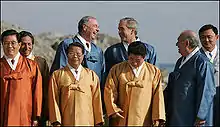Durumagi
Durumagi is a variety of po, or overcoat in hanbok, the Korean traditional garment. It is usually the topmost layer of clothing that is worn over jeogori (jacket) and baji (pants). Durumagi means "closed all around", and is also known as jumagui (주막의, 周莫衣), juchaui (주차의, 周遮衣) or juui ( 주의, 周衣). Durumagi is worn not only to fend off the cold, but also for ceremonial purposes.[1]
| Durumagi | |
| Hangul | 두루마기· 주막의· 주차의· 주의 |
|---|---|
| Hanja | |
| Revised Romanization | durumagi / jumagui / juchaui / juui |
| McCune–Reischauer | turumagi / chumagi / chuch'ai / chui |
History
The origin of durumagi traces back to at least the Three Kingdoms of Korea(57 BC - 668 AD, it was influenced by a long coat worn by northern Chinese to fend off cold weather in ancient times[2][3][4][5], such form of clothing is called Zhiju (直裾), developed since Shang Dynasty. Two examples of Zhiju can be found in Mawangdui (马王堆) BC 206-24 and Mashanchumu (马山楚墓) BC 770-476. [6][7] It was adapted and worn by the upper class in various forms for ceremonies and rituals, then the modified form was introduced to the general population came to be known as the durumagi. [8] Mongolian influence during the Goryeo period caused changes in its appearance.[9] Not only was the waist belt changed into a goreum, the traditional po's short length and wide sleeves were lengthened and narrowed to the style of the Mongolian coat xurumakci, of which the name durumagi is said to be derived.[10]
During the Joseon Dynasty, the durumagi was less worn as an overcoat but more of a housecoat for the noble class, whereas it was worn outdoors by the commoners. In 1884, King Gojong promulgated the unification of clothing for all social classes through reform laws. [11] However, this law was met with much resistance and it was only until ten years later, after the Gabo Reform of 1894, that the durumagi became common as formal attire. [9]
Types and characteristics

Different fabrics and materials are used in making durumagi: calico, wool, cotton, and various silks for winter; ramie, fine ramie and silk gauze for summer; various silks and calico for spring and autumn.[1] White, grey and navy blue are commonly used.[12]
Various types include hotedan durumagi (홑단 두루마기, single layer), gyup durumagi (겹두루마기, double layer), som durumagi (솜두루마기, cotton), and kkachi durumagi (까치두루마기, magpie) or obangjang durumagi (오방장 두루마기, five colors) for children. [13]
Modern use

The 'durumagi' is still considered an important part of traditional attire for formal occasions,[14] but a variety of colors and designs are being used. Colorful durumagis were given as gifts to the world leaders of the 2005 APEC Summit in Busan.[15]
See also
References
- (in Korean) Durumagi at Doosan Encyclopedia
- Lee, Samuel Songhoon (2013). Hanbok: Timeless Fashion Tradition. Seoul Selection. pp. 13–14. ISBN 9781624120565. Retrieved 2 February 2021.
- Wang, Bo (961). 唐会要 新罗 TangHuiYao - Silla. Retrieved 6 February 2021.
- Wei, Shou (551–554). 魏书 百济 Book of Wei - Baekje. Retrieved 6 February 2021.CS1 maint: date format (link)
- Wang, Qinruo (1013). 冊府元龜 Cefu Yuangui-chapter 936&975. Retrieved 5 February 2021.
- "3.3.1 直裾长衣". MaShan muesuem. Retrieved 5 February 2021.
- 长沙马王堆一号汉墓发掘简报. Institute of Archaeology, Chinese Academy of Social Sciences. 1972-07-01. Retrieved 5 February 2021.
- Lee, Samuel Songhoon (2013). Hanbok: Timeless Fashion Tradition. Seoul Selection. pp. 13–14. ISBN 9781624120565. Retrieved 2 February 2021.
- (in Korean) Durumagi Archived 2011-06-10 at the Wayback Machine at Nate Encyclopedia
- Lee Yi Hwa (이이화), Korean History 7 - the Mongolian Invasion and the 30 Years War (한국사 이야기 7 - 몽골의 침략과 30년 항쟁), 1999, p.58 Hangilsa, Paju. ISBN 89-356-5146-X
- (in Korean)Gapsin Clothing Reform at Doosan Encyclopedia
- (in Korean) New hanbok, Herald Biz 2010-03-30, Retrieved 2010-06-14
- (in Korean) Obangjang durumagi from Daum Communications and Korea Culture & Content Agency
- (in Korean) Durumagi a must, bnt news 2010-02-14
- (in Korean) Leaders in durumagi, Nocut News 2005-11-25
- Lee Ho-jeong (2007-05-07). "Clothing with stories of fertility and faith". JoongAng Daily.
External links
- Korea National Heritage online from the Cultural Heritage Administration
- (in Korean) Hanbok Story
| Wikimedia Commons has media related to Durumagi. |
